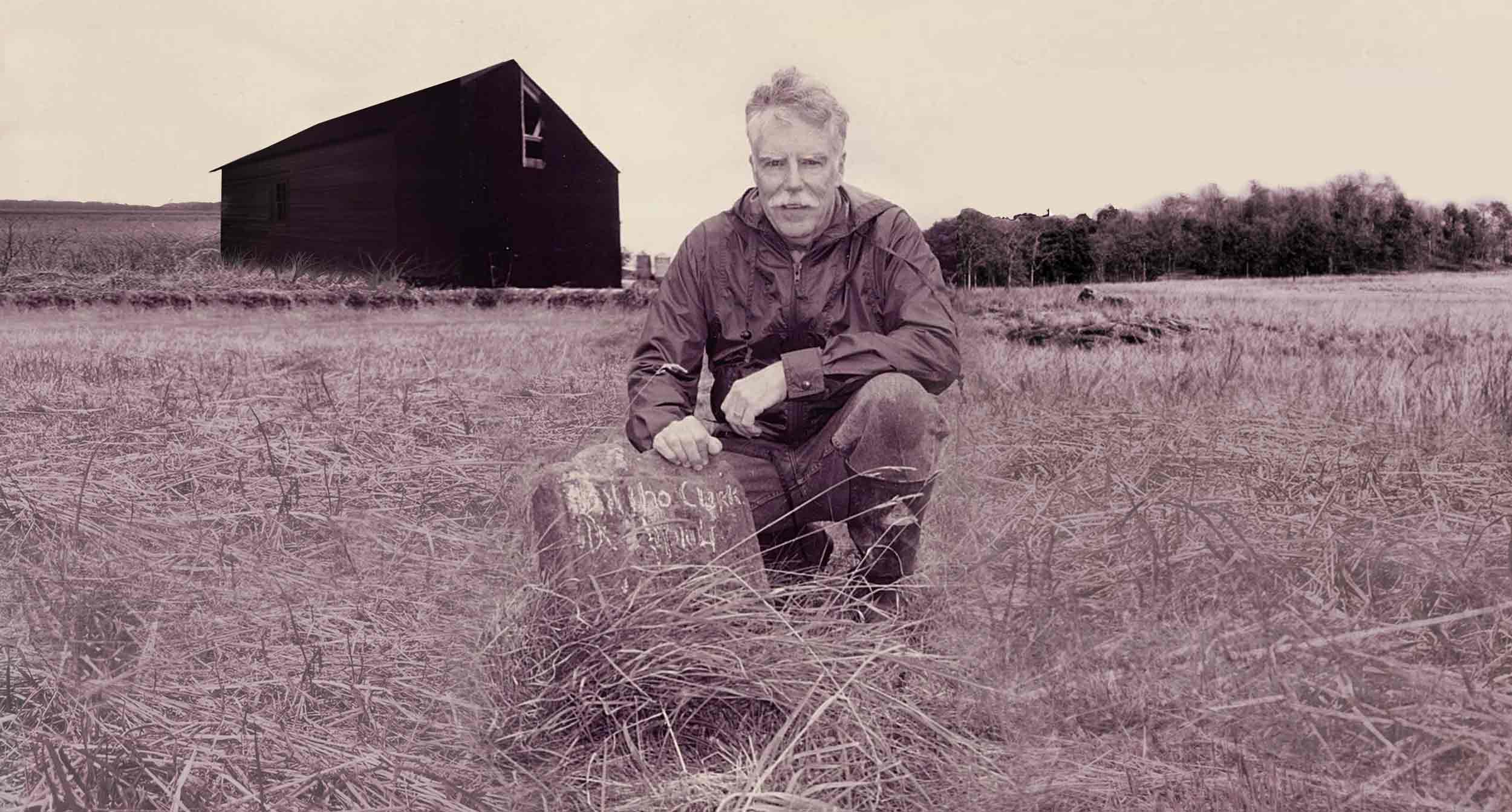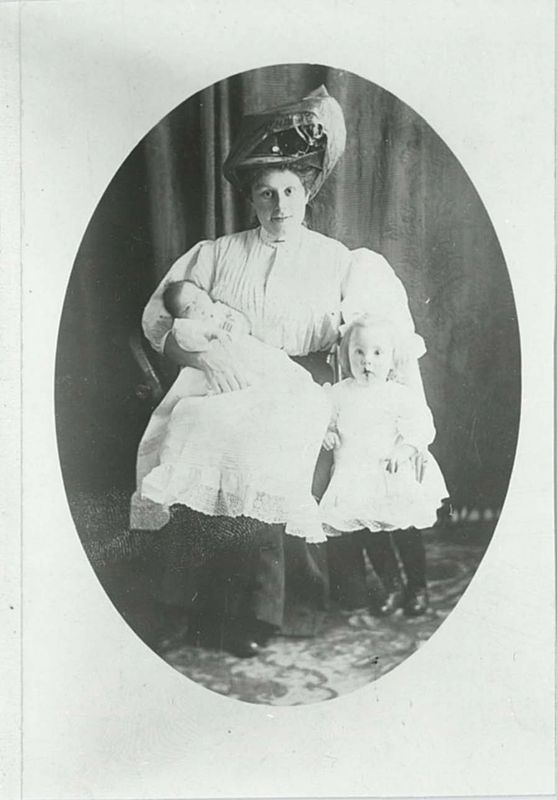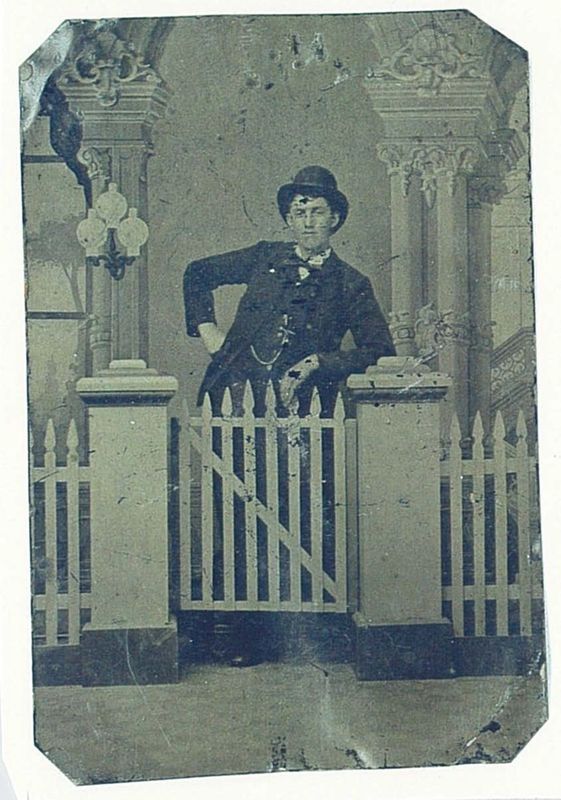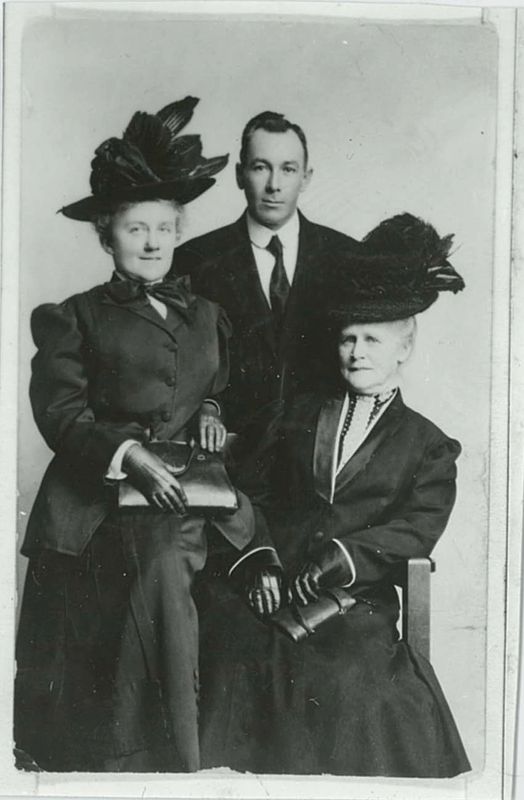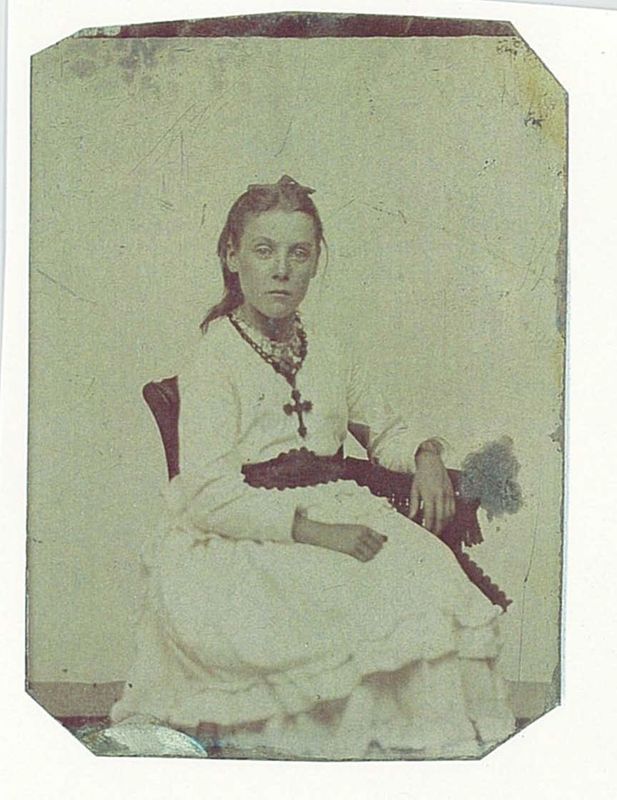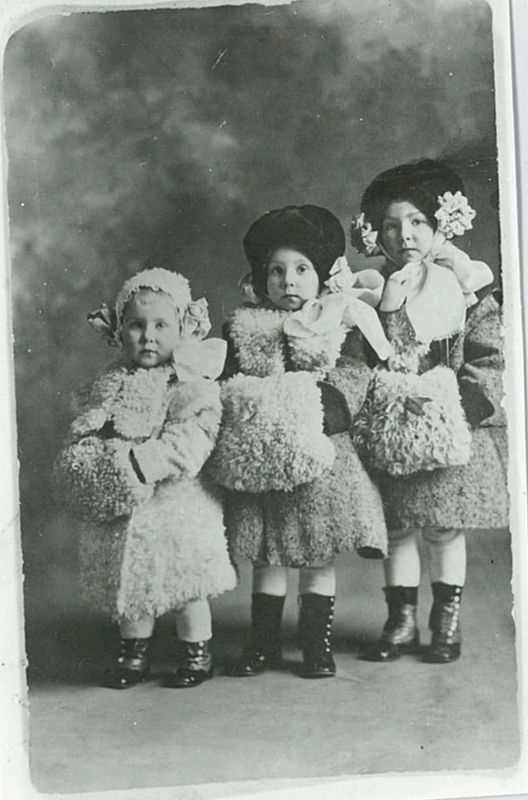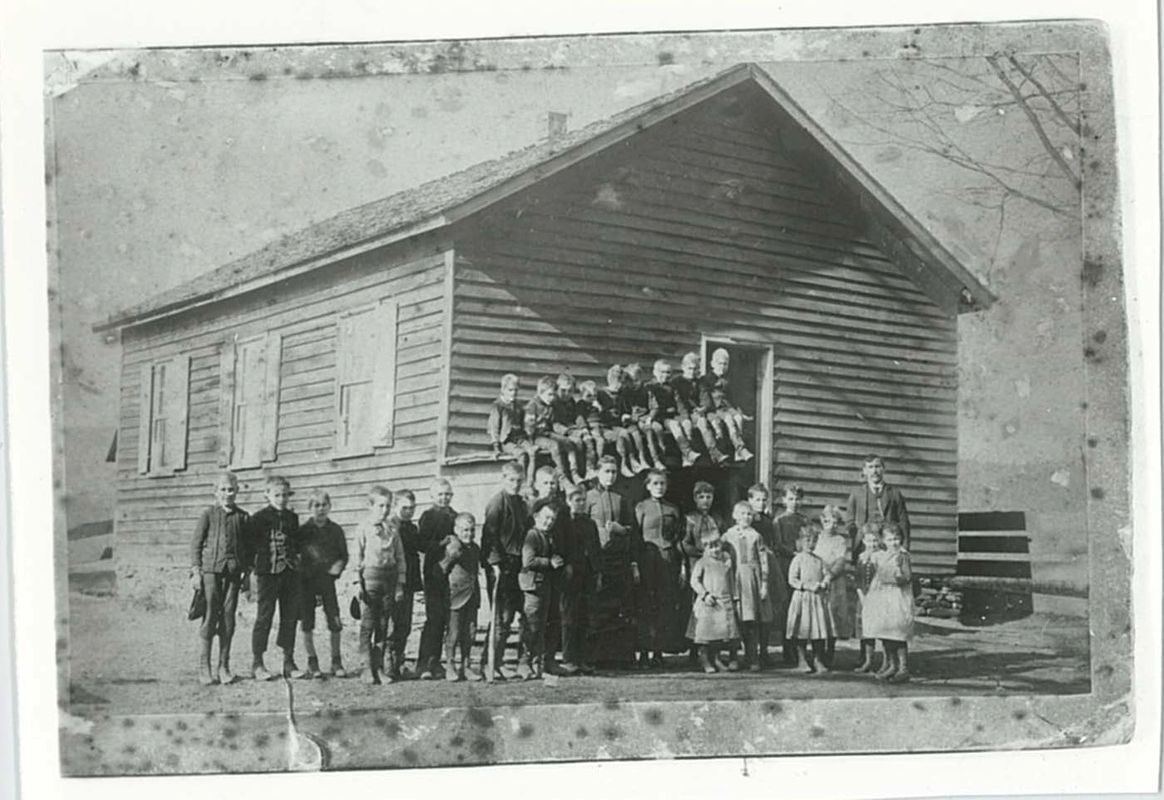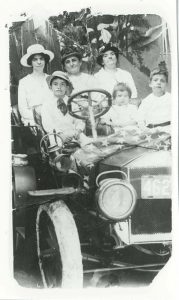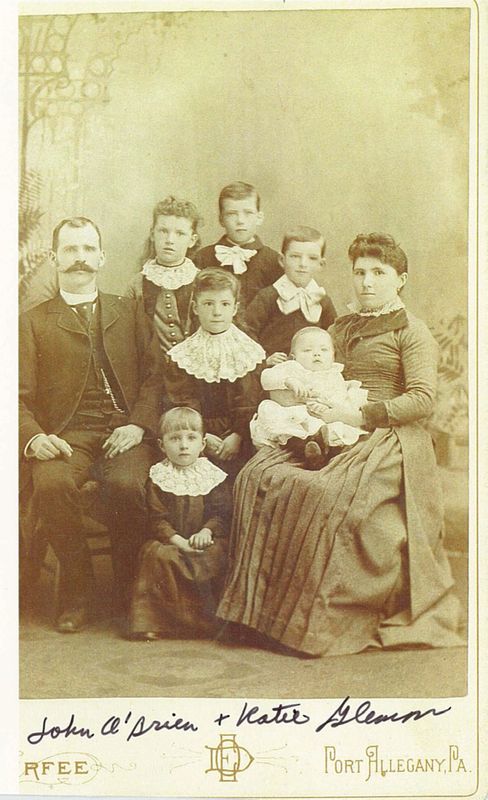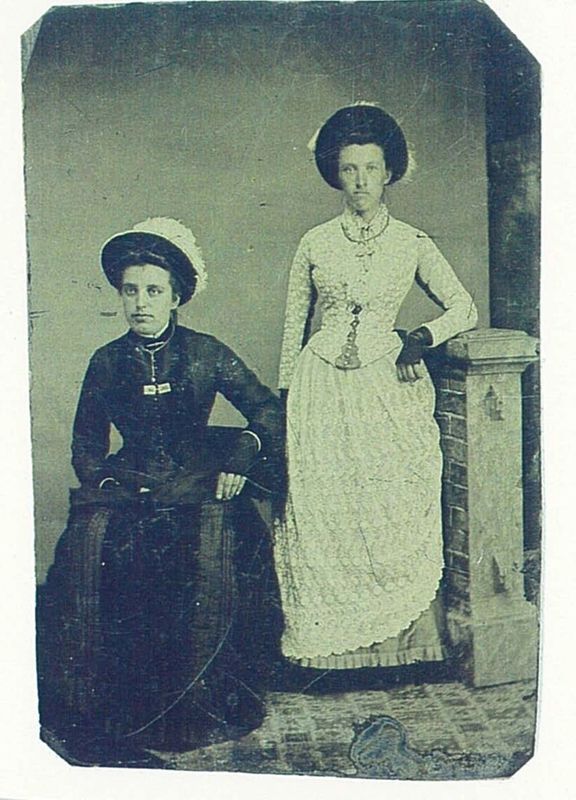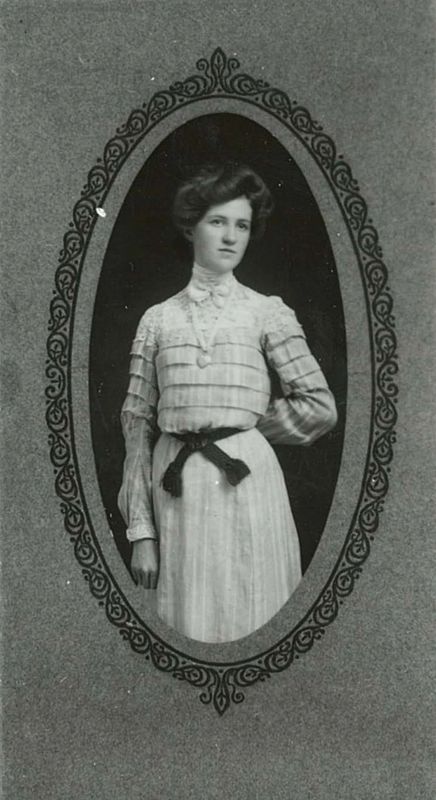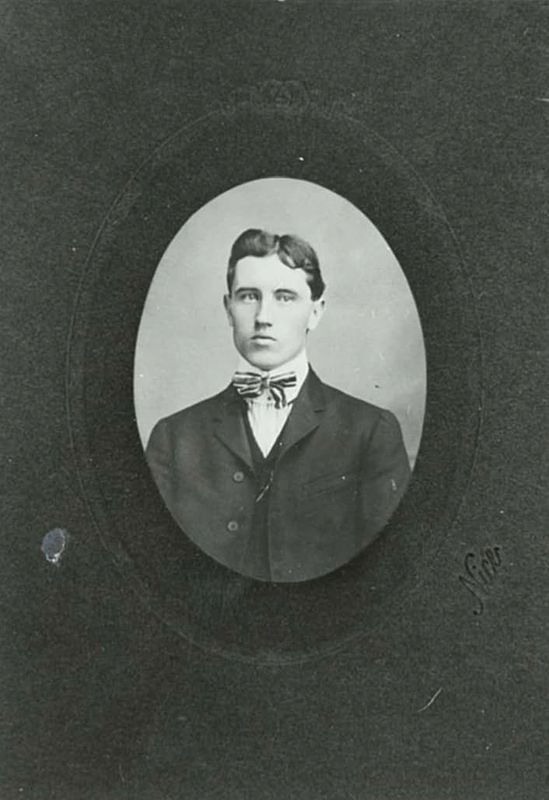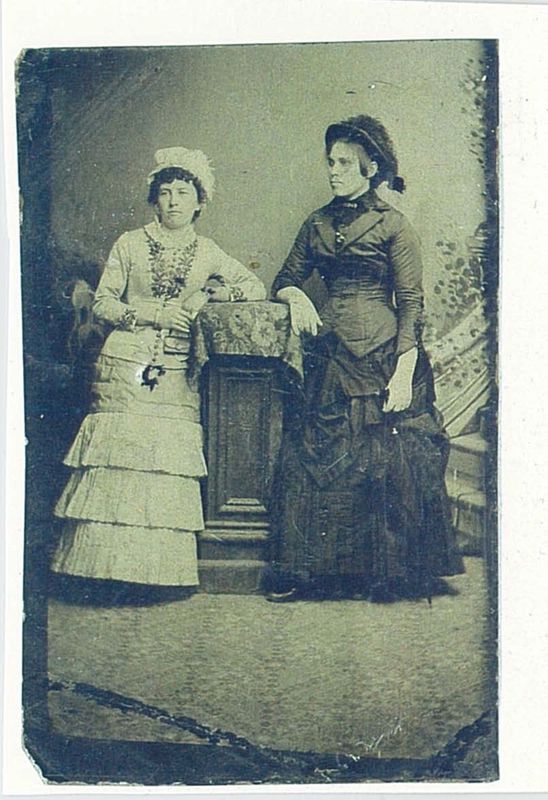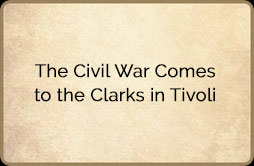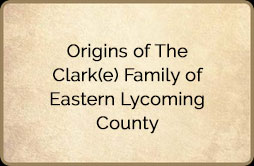Origins of The Clark(e) Family
of Eastern Lycoming Counties
by P. Clarke Glennon
Member, Muncy Historical Society and Lycoming County Genealogical Society
N.B.: Throughout this article, I have rendered the name “Clark” or “Clarke” just as the person referred to spelled his or her own name and as the record being referred to spelled it.
Gabriel Clarke of Yorkshire, England, and the Grange, County Antrim, Ireland.
The recorded history of the Clark(e) family of eastern Lycoming County begins before 1650 in Yorkshire, England, with Gabriel Clarke, the son of a farmer there. Gabriel’s life and family are recorded in a manuscript that was written in Ireland. The story starts with John Clotworthy, Lord Massarene from County Antrim, Ireland, who was passing through Yorkshire with his retinue when he came across a young man building two mills “for grinding corn.” Lord Massarene admired the ingenuity of the mills, saying, “no such have I ever seen in Ireland.” He then asked the young man’s father if he could take Gabriel back to Ireland so as to instruct his men how to build such mills. The father refused the Lord’s request, but evidently young Gabriel Clarke liked the idea for he hid himself among Lord Massarene’s followers and accompanied them to Antrim Town in northern Ireland.
There, Gabriel built “as many of the mills as Lord Massarene had use for.” As a reward, he was given a lease in perpetuity to an estate at a place called the Grange (of Ballyscullion) near Toome, County Antrim. While living there Gabriel “was convinced” and became a Quaker. Lord Massarene approved of Gabriel’s conversion because he was favorably disposed toward dissenters. Gabriel married soon after, built two mills, and “set up merchandize.”
On page 91 of John Rutty’s History of the Rise and Progress of the Quakers in Ireland, he says that in about 1655 “a meeting was settled at the house of Gabriel Clark, an honest, religious, antient man, who received Truth as also his Wife and Family.” Gabriel later gave land to the Friends for grazing their horses while at meetings in his home.
Gabriel Clarke and his wife had four documented children, three sons and a daughter. The three sons, in the order of their age, were Bartholomew, Nathaniel, and Walter. The daughter, Ann, was married to James Greenwood, a Friend who also belonged to the Grange Meeting. More about these sons shortly.
The Irish manuscript on this family reports that Gabriel was the only son of his father and that he wrote a will dividing his estate among his own three sons, each with land and a house of his own and an equal portion of the ownership of the mill. While this will is not available today, transcripts of the wills of each of Gabriel’s above-named three sons deal with the disposition of their one-third of the family mill, thus confirming that part of the story.
Gabriel Clarke also gave land for a Friends graveyard; and he and his wife were reported to have been the first to be buried in it, probably in the early 1690s. This graveyard is called the Green Garden and is still, to this day, in use by the descendants of these families.
**[Here or near here, include the photo of Clarke Glennon taken in the Green Garden]*
Other Clarkes of the Grange
There are several other Quaker Clarkes at the Grange who need to be discussed. There is a Samuel Clarke “of the Grange, Co. Antrim,” who was disowned in 1685 by the Quakers of Ballyhagan Men’s Meeting after many years of dissatisfaction with his “walking in his life and his conversation.” This is very probably the same Samuel Clarke who witnessed the deed in 1696 when Bartholomew Clark transferred the ownership of the Grange cemetery to Walter Clark and James Greenwood on behalf of the Quaker Meeting. Nathaniel Clark also witnessed this deed.
Samuel Clarke, a man who by 1685 had been an adult for “many years,” is unlikely to have been a grandson of Gabriel. If we accept the assertion that Gabriel was an only son, then it seems most likely that Samuel was a son of Gabriel’s, perhaps the oldest.
Both Bartholomew and Walter had oldest sons to whom they did not will an interest in the family mill. Perhaps older sons were more likely to have established their economic place in the world before their fathers wrote their wills. This could be the reason they were not willed major family assets. Or perhaps Samuel was out of favor with his father because of his disownment from the Meeting. Recorded leases at the Grange by this “Samuel Clark, gentleman,” reveal sons John, Robert, and Samuel and a daughter, Ann Courtney, as well as grandsons Samuel, born 1702, and Robert Clark.
There is another resident of the Grange to be accounted for, William Clarke. The book Account of the Life of Adam Clarke, an autobiography by this famous Irish early Methodist clergyman, tells a story about how his ancestor, William Clarke, a Quaker and resident of the Grange, County Antrim, greeted William of Orange when he arrived at Carrickfergus, Ireland, in 1690. Land leases at the Grange record a 1721 lease to William Clark, blacksmith, and mention his sons Gabriel, born 1696, and Sampson. This William is obviously part of the family of the Gabriel Clarke who came from Yorkshire. Judging by the wills of the first Gabriel Clarke’s sons, we can say that William is most likely not a son of Bartholomew, Nathaniel, or Walter. By process of elimination, it seems logical to assign him as a son of Samuel Clarke and therefore tentatively a grandson of the first Gabriel Clarke.
Adam Clarke’s autobiography tells of a son of William’s, named John, who married Anne Horseman and had one daughter, Sarah Williamson, and 18 sons, including: Samuel, Anthony, Joseph, Robert, Walter, John, Richard, Horseman, and William. The last-named son, William, was the grandfather of the famous author and clergyman, Adam Clarke. This William had sons John, father of Adam Clarke; Archibald; William; and Adam. Adam Clarke (?1760-1832) was the most influential British Methodist in the generation after the denomination’s founder, John Wesley.
Bartholomew Clarke of the Grange, Son of Gabriel
Gabriel’s oldest documented son, Bartholomew, died in 1716 leaving a will that named sons Nathaniel and James, each of whom received half of their father’s one-third of the mill. The will also named a son Walter and daughters Jane and Mary. Bartholomew’s son James married Sarah Haydock in 1706 at Grange Meeting. Another manuscript also names an oldest son of Bartholomew, Gabriel, although he is not mentioned in Bartholomew’s will. This oldest son, Gabriel, was born in 1673, married twice, and had six sons and six daughters. He died in Youghal, County Cork, Ireland, in 1739.
In about 1718 a Walter Clark with origins at the Grange, County Antrim, appears in the Chester County, Pa. Tax Records. Gilbert Cope, a knowledgeable Chester County, Pa., historian, has a credible belief that this Walter Clark was Walter the son of Bartholomew and grandson of the original Gabriel Clarke. This Walter’s wife was Deborah, and among their children were Gabriel, who died in Kennett, Chester County in 1792; John, who married Ann Young in 1743 and moved to Woodbridge, N.J.; Joseph; James; and probably others. This is a very prolific line in Chester County that, early on, spreads westward to the Susquehanna River and beyond, some turning northward to found Clarks Ferry, Perry County, Pennsylvania and others heading south into the Appalachians.
Also, there is a County Antrim manuscript that says a Nathaniel Clarke from the Grange family went to Philadelphia with seven children. There is no date for this emigration, and there are several Nathaniels this could have been; but the assertion in the Irish manuscript is that it was Nathaniel, the son of Bartholomew, who went bankrupt at the Grange. I have not been able to locate the family of this Nathaniel in the U.S.; but in addition to Pennsylvania, they could have ended up in nearby Maryland, Delaware, or New Jersey. One researcher has said that this family moved from Chester County into Lancaster County, but I have been unable to confirm this.
Nathaniel Clarke of the Grange, County Antrim, Son of Gabriel
The second documented son of Gabriel Clarke, the founder of this family in Ireland, was Nathaniel Clarke. Like his brothers he received land, a house, and a one-third interest in the mill from his father. There is a will of a Nathaniel Clarke of the Grange, who died in about 1730 and appears to be this son of Gabriel. The will names Nathaniel’s son Samuel, giving him “my part of the mill, houses, gardens, and orchards and he is to pay debts.” The will additionally names his sons Bartholomew, Jeremiah, and Nathaniel, who receive bequests, as well as daughters Elizabeth, Jane, and Sarah.
Walter Clark of the Grange, County Antrim, Son of Gabriel
The third documented son of Gabriel Clarke was Walter. This is the line that finds its way to Lycoming County, Pennsylvania. In 1684, Walter Clark married a widow, Mary Courtney, at the Grange. Inferences from the 1725 will of Walter indicate that he and Mary had two children, Gabriel Clark and Ann Mercer, probably the wife of Moses Mercer of Hillsborough. (A shift in spelling of the name seems to occur here from “Clarke” to “Clark.”)
After the death of his first wife, Mary Courtney, Walter married again in 1690 to Elizabeth Haddock. This couple had six children: John, Samuel, Abigail, Priscilla, Jane, and Elizabeth.
At Ulster Province Meeting, 2 Mo. 14, 1705 (April 14, 1705), it was recorded that “Walter Clark hath built a meeting house at Grange for ye Service of truth and use of Friends.” This meetinghouse was built on the land that Walter’s father, Gabriel, had given to the meeting.
When it came to his will, Walter divided his estate differently than his brothers did. To his son Gabriel he gave the land, houses, orchards, and gardens that he held by lease from Lord Massarene and from Samuel Clarke, deceased. To his wife, Elizabeth, he gave “all my other lands, etc. with my part of ye mill during her life for the maintenance & education” of their six children.
After Elizabeth’s death, their son John was to receive “ye house which Walter and Elizabeth lived” in as well as “all my houses on this side of the river.” Samuel was also given a house. The one-third of the mill that Walter owned was to be divided between John and his brother Samuel. The sum of £50 was to be divided between the four unmarried daughters. The only dates that I have been able to discover for Walter’s children are the births of Samuel in 1711 and Elizabeth in 1714, perhaps the two youngest children.
The name of the wife of Gabriel Clarke, the founder of the Grange family, is not recorded in any documents uncovered to date. However, the wills of each of Gabriel’s three sons list a daughter named Jane, and for this reason I wonder if this might have been her name.
It is evident from the wills and estates of these sons of Gabriel Clarke that this family became very well-to-do in their time and place.
Samuel Clark of Grange, County Antrim, Chester County and Bucks County, Pennsylvania, Son of Walter
The next events for this family occur in Chester County, Pennsylvania. John Clark appears at Kennett Monthly Meeting on 7 Mo. 6, 1729 (Sept. 6, 1729) and presents a removal certificate from the Grange dated 3 Mo. 27, 1729 (May 27, 1729). His brother Samuel, age 18, appears at the same meeting on 8 Mo. 4, 1729 (Oct. 4) with a certificate from the Grange also dated 3 Mo. 27, 1729. Each of these certificates notes that they are the son of Walter Clark of the Grange.
On 12 Mo. 3 1732/33 (Feb. 3, 1733), Samuel Clark decided to return to Ireland so abruptly that the Kennett Monthly Meeting did not have time to go through the normal procedures for preparing a removal certificate for him. Consequently, two men were instructed “to inquire into his conversation and clearness on the account of marriage and if nothing appears to obstruct, to prepare a certificate for him and produce to the next monthly meeting.” On 1 Mo. 3, 1732/33 (Mar. 3, 1733) “The friends appointed to prepare a certificate for Samuel Clark have accordingly done it which was here read and approved and signed by order of said meeting.”
Samuel’s mother, Elizabeth Clark, the widow of Walter, died at the Grange about 1732, and this probably was the reason for his swift return to Ireland. Samuel and his brother John had inherited a one-third interest in the mill at the Grange, as well as other property upon their mother’s death. Since they were now committed to living in Chester County, Pennsylvania, the disposal of their interests at the Grange needed to be taken care of. Records at the Grange seem to indicate that Samuel and John’s older brother Gabriel was now managing their father’s holdings. While he was in Ireland, Samuel lived at Hillsborough not far from Lisburn, County Antrim.
Samuel was again received at Kennett, Chester County, with a removal certificate from Lisburn Meeting on 1 Mo. 6, 1735/36 (March 6, 1736). It notes that he is “unmarried, having for some time past dwelt at Hillsborough which is a branch of our Meeting.”
Samuel evidently brought his sister back to Chester County with him, because the Kennett Meeting notes that Elizabeth Clark, daughter of Walter Clark, unmarried, also was received 1 Mo. 6, 1735/36 (March 6, 1736) from Antrim Meeting. The certificate reads, “She was born and Educated at Grange within the Limits of this Men’s Meeting, and her parents were friends in Unity with us, (whose memory is dear unto many of us).” She had also most recently lived at Hillsborough Meeting, probably with her brother Samuel and/or her sister Ann Mercer.
Elizabeth Clark wasted no time after her arrival in Chester County. On 5 Mo. 7, 1736 (July 7, 1736) she married Benjamin Jackson, son of Thomas Jackson at Kennett Meeting; both Elizabeth and Benjamin were listed as of East Marlborough.
Elizabeth’s two brothers were not far behind her. On 8 Mo. 6, 1737 (Oct. 6, 1737) at New Garden Monthly Meeting, Samuel Clark of East Marlborough married Mary Lightfoot, the daughter of Michael Lightfoot and Mary Newby of New Garden. And on 1 Mo. 7, 1737/8 (March 7, 1738), at Kennett Meeting, Samuel’s brother John Clark married Hannah Cooper, the daughter of James and Mary Cooper. John and Hannah Clark had children: Elizabeth (1738), James (1740), Walter (1742), John, William (1747), Samuel (1749), Mary (1749), and Hannah (1752).
Lightfoot, Newby, and Edmundson Families
Mary Lightfoot’s family were also Irish Quakers. Her father, Michael Lightfoot (about 1683–1754), and his wife, Mary Newby, were received 4 Mo. 7, 1712 (June 7, 1712) from Catterlaugh (Carlow) Monthly Meeting, Ireland. Michael’s father, Thomas Lightfoot, was a prominent Quaker minister who was born in Cambridgeshire, England, in about 1645 and was probably the son of another Thomas Lightfoot there. Michael’s father, Thomas, was at Lisburn Meeting in northern Ireland in 1692, and moved to Moat Meeting, County Westmeath, in 1694, and to Chester County, Pennsylvania, in 1716 along with a number of his children. Thomas died in Darby, Pa., in 1725. In 1743, Michael Lightfoot moved to Philadelphia to assume the post of Treasurer of the Province of Pennsylvania, an office he held until his death, 12 Mo. 3, 1754 (December 3, 1754).
Michael Lightfoot’s wife, Mary Newby, who was born in Dublin in 1677, also came from a prominent Quaker family. She was the daughter of John Newby and Grace Edmundson. Grace in turn was the daughter of Thomas and Anne Edmundson of Little Musgrove, Westmoreland, England. Thomas was the brother of William Edmundson, the well-known founder of the Society of Friends in Ireland. The brothers William and Thomas Edmundson and an unnamed cousin were convinced as Quakers the same day after hearing James Naylor, one of the founders of the Society of Friends in England, speak.
On 6 Mo. 5, 1738 (Aug. 5, 1738), Kennett Meeting issued a removal certificate for Samuel Clark to the Monthly Meeting at North Wales, Montgomery County. About that time, Samuel and Mary Lightfoot Clark moved to Milford Township, Bucks County, where they belonged to the Richland Monthly Meeting. This meeting had initially been under the supervision of North Wales. Richland Meeting records the births of Samuel and Mary Clark’s eight children: William, 1739; Sarah, 1741; Elizabeth, 1743; Michael, 1744; Mary, 1746; Abigail, 1747; Walter, 1749; and Samuel J., 1751.
William Clark of Bucks and then Lycoming Counties, Son of Samuel Clark
The marriage of William Clark, the son of Samuel and Mary, to Hannah Lloyd is recorded at Richland Meeting in 1766. It is very probable that Hannah was the daughter of Thomas Lloyd, Jr. and Sarah McVeagh, also of Richland Meeting. The children of William and Hannah Clark are noted in the records of Richland Meeting as: Thomas, born 1766, who evidently died young; Martha, 1767; Gabriel, 1769; Thomas, 1770; William, 1771; and Eleazer, 1773.
The Lloyd Family
Thomas Lloyd, Jr. was of the family of Welsh Quakers of Merion, Montgomery County, Pennsylvania. His father, Thomas Lloyd, Sr., came to Pennsylvania between 1682 and 1698 and married, at Merion Meeting, Elizabeth Williams. Elizabeth was the daughter of William ap Edward (by his first wife Katherine), who arrived in Pennsylvania in August 1682 on the ship Lyon. William ap Edward was from Ucheldri near Bala, in Merionethshire, Wales. William’s father was Edward ap John of the township of Cynlas, Llanddervel Parish, Penllyn, Merionethshire. Edward ap John was in turn a descendant of Rhirid Flaidd, Lord of Penllyn, a 12th-century Welsh chieftain. Thomas Lloyd, Sr., who married the daughter of William ap Edward, was the son of Thomas and Lowry Lloyd of Panmaen, Merionethshire, Wales. Radnor Monthly Meeting, in 1729, records a removal certificate for Thomas Lloyd, Jr. of Merion to Gwynedd Monthly Meeting to marry Sarah McVeagh, both of whom already lived on the verge of that meeting (in Richland).
In 1790 William Clark was officially received at Exeter Monthly Meeting near Reading, Berks County. Six of his children are listed as accompanying him. They were Gabriel, Thomas, Isaac, Mary, John, and Hannah. These last four had evidently been born after Eleazer in 1773, but I could find no record of the place or year of their birth. In fact, it is probable that this family went on to Catawissa Monthly Meeting, which was originally Northumberland and is presently Columbia County, Pa., and then on to Muncy Meeting in Pennsdale, Lycoming County, both of which were under the care of the Exeter Meeting.
The Maiden Creek Meeting, Berks County, records the marriage in 1790 of Martha Clark, the daughter of William Clark, to Moses Starr, the son of Merrick Starr and Phebe Pearson. Both Moses and Martha were reported to be of Muncy Meeting. The absence of William’s wife, Hannah, in these latter records, including the marriage of their daughter Martha, indicates that Hannah had died earlier.
In the 1790 Northumberland County census, on page 44, are some listings that appear to be located in what later became Muncy and then Wolf Township, Lycoming County. This page includes Enos Lundy, who purchased his property in Muncy Township from Samuel Wallis in 1784. Also on this same 1790 page are the families of Moses Starr and William Clarke. These last two families include, beyond William Clark, Moses Starr and new wife, Martha Clark Starr, a total of two males of 16 years and above, two males under 16, and two more females. This number fits the list of children William Clark brought with him from Bucks County namely: Gabriel, Thomas, Isaac, John, Mary, and Hannah Clark.
The record of deeds in the Lycoming County courthouse shows that, in 1796, William Clark of Muncy Township purchased more than 38 acres in that township from Enos Lundy and his wife, Rachel. The description of the boundaries of the land say it is adjacent to land owned by Moses Starr. By the 1800 and 1810 censuses, the Moses Starr family is listed in Loyalsock Township.
Gabriel Clark of Bucks and Lycoming Counties, Son of William Clark
William Clark’s son Gabriel accompanied him to the Susquehanna Valley from Bucks County. In 1789, the Pennsylvania Archives 6th Series, Volume 3, page 918, lists Gabriel Clark in “the company of Captain Cornelus Waldron of the Melitia of the third Batelion of Northumberland County commanded by Coll. William Hepburn.” Cornelius Waldron lived in the Turbot area of Northumberland County. Gabriel was beginning to do things that were not Quaker-like.
In 1795 Gabriel Clark married Mary Hilborn, the daughter of Samuel Hilborn of Catawissa. Samuel Hilborn was a Quaker in good standing, but his daughter Mary was not. Consequently, the responsible Exeter Meeting on 8th Mo. 26, 1795 (Aug. 26, 1795) lists Gabriel Clark as having married contrary to discipline. The Exeter records, in their minutes, say that the Catawissa Preparative Meeting reports they were informed by one of their overseers that Gabriel Clark “hath accomplished his marriage by the assistance of a Justice, he having been precautioned.” And 10th Mo. 7, 1795 (Oct. 7, 1795) Gabriel Clark was disowned for marrying someone not in membership and by help of a justice of the peace.
The Hilborn Family
The Hilborn family originates in North Petherton, Somerset, England, where Thomas Hilborn was born in 1655, the son of Robert Hilborn, a Quaker, and his wife, Mary Hayes. Thomas left England in 1670 as an indentured servant, first arriving in New England and then Shrewsbury, N.J., where he married Elizabeth Hooten in 1688. He moved, finally, to Newtown, Bucks County, Pa., in 1703. Their son Samuel Hilborn (1689–1714) married Margaret Atkinson in 1711 and lived in Newtown. In 1736 Samuel and Margaret’s son Samuel Hilborn, Jr., born 1714, married Abigail Twining , daughter of Stephen Twining, and lived in Makefield Township, Bucks County. Samuel and Abigail’s son Samuel Hilborn III (1737–1820) married a woman named Mary about 1760 and had children: Elizabeth, 1762; John, 1766; Sarah, 1769; Amos, 1771; Samuel, 1775; Mary, 1776; Susannah, 1779; William, 1781; Abel, 1783; Eleanor, 1785; and Ann, 1787. Samuel Hilborn III began his life in Bucks County, Pa., later lived in Northampton County, and died in Catawissa, presently Columbia County, Pa., in 1820 and was buried at Roaring Creek Meeting.
As noted earlier, William Clark moved from Catawissa to the Muncy area, where he was a member of the Muncy Friends Meeting at Pennsdale. In addition to the 1790 census, William is listed in Muncy Township in the 1800 U.S. census. By the 1810 census, William, Gabriel, and John Clark are listed in Muncy Township as living side by side. Evidently the fact that Gabriel Clark had been disowned by the Quakers did not estrange him from his family. The probate records of Lycoming Co. show that on March 1, 1814, Letters of Administration were issued to John Clark for William Clark deceased, with Gabriel Clark and William Cox Ellis as sureties. Muncy Meeting records note the death of William Clark under the year 1814. Undoubtedly he was buried in the Muncy Friends cemetery at Pennsdale but without a marker as was the Quaker custom. William’s son John married and moved to Ohio in 1823.
We are fortunate that one of Gabriel Clark’s grandsons, Henry R. Clarke of Muncy, wrote down the known information about Gabriel’s family in an 1893 manuscript titled “Genealogy of Samuel H. Clark, son of Gabriel Clark, son of William Clark.” This manuscript can be found in the collection of the Historical Society of Pennsylvania in Philadelphia, where I first saw it, and also in the Hughesville Public Library where I donated a photocopy a number of years ago. It is also available in the Lightfoot Collection at the James V. Brown Library in Williamsport, and copies may also be in other repositories. It is a fascinating period piece.
Credit for the preservation of this manuscript should be given to Margaret C. Clarke, born 1881, the daughter of Henry R. Clarke, who in November 1939 typed up her father’s handwritten pages and started them on their journey to us today. Decades ago, when I was visiting the newly rebuilt Muncy Library, I was talking with the librarian about this manuscript and said that the copy in Philadelphia was typed on the back of a business letterhead titled “Margaret C. Clarke, Insurance, Muncy, Pa.” The librarian said, “Do you mean Maggie Clarke? She was a nice lady.”
Discerning readers will notice that Henry R. Clarke added an “e” to the end of his name. I can also report that two of his first cousins, I. Coleman Clarke and his brother, my great-grandfather Laverne J. Clarke, also added an “e” to their names about the same time. Their descendants have carried on this spelling. I’m not sure why they did that, but my guess is that they realized that Irish usage most often renders Clarke with an “e,” and Henry Clarke’s manuscript was recording the family’s origins in Ireland. That is only supposition, of course. The rest of the family has continued to use “Clark.”
In collecting the oral history of the family in 1893, Henry got most things right, but he did mix up a few things. He describes his great-grandfather William Clark as born in Ireland, whereas it was William’s father, Samuel, who was born in Ireland. He reports that the Clark family once lived in New Jersey, but I could find no evidence of that. An interesting supposition is that he got this from Aaron Clark, who was born in New Jersey, moved to Lycoming, and married Henry’s aunt, Susan Clark. Both Henry and Aaron’s families lived for some time near each other in Wolf Township. If Aaron was related to the Lycoming Clarks and was from N.J., he may have told Henry that the Clark family originated in New Jersey. This is food for thought only.
Siblings of Gabriel Clark in Lycoming County
Henry Clarke’s manuscript lists six of William Clark’s children: Gabriel, Eleazer, John, Hannah, Martha, and Mary. They were known and remembered by Gabriel’s descendants in Lycoming County. The Quaker Exeter Meeting removal record, which is quoted above, lists Gabriel, Thomas, Isaac, Mary, John, and Hannah as accompanying William from Bucks County, in addition, of course, to Martha Clark Starr. So the two lists have much in common.
Martha Clark Starr can be counted as documented by Quaker marriage records. William’s son John Clark is recorded in Pennsdale Quaker records as marrying Rachel Parker in 1808 and taking his family to New Garden Meeting in Ohio in 1823. Family witnesses to John Clark’s 1808 marriage, in addition to his father, William, include Martha Starr, Mary Clark, and Hannah Clark. The list of John and Rachel Clark’s children from Muncy Meeting records shows Rebecca, Martha, Thomas, Henry, William, Arthur, Jane, and John.
An Isaac Clark, who might conceivably be the brother of Gabriel, appears in an 1809 Lycoming County probate record as a surety. An Eleazer Clark and his family are listed in Deerfield Township, Tioga County census records in 1820 through 1860, but he is shown as born in Rhode Island in the 1850 record and born in New York in the 1860 record, casting doubt on the possibility that he is the Eleazer Clark from this family. Also, the Deerfield Eleazer says that he was born 1788, whereas Gabriel’s brother was born 1773. It appears questionable that this Eleazer is Gabriel’s brother, more because of his reported place of birth than the year of his birth. A Y-DNA test of one of his male Clark descendants would settle this question.
Gabriel’s sister Hannah seems clearly to be in Lycoming County as documented by Quaker records, but probably passed from view when she married after 1808, possibly to a local Quaker. An additional interesting question is raised by the fact that Henry R. Clarke attached to his manuscript, without explanation, his transcription of the Bible record of the family of Robert (1768–1824) and Mary (1776–1858) Clark of Delaware Township, Northumberland County, not far from Muncy. Obviously Henry hitched up his horses, got into his wagon, and drove to Delaware Township for the express purpose of copying this Bible record, so it clearly had significance for him. Can this Mary be the sister of Gabriel? Her date of birth in 1776 is about right. If so, she would have had to marry a man with the same surname as her own — not impossible but not the most likely scenario either. So, for now, the Clarks of Delaware Township, Northumberland County, have to remain just a family of interest in the study of the Clarks of the Grange.
The Henry R. Clarke manuscript lists 14 children of Gabriel and Mary Hilborn Clark “that lived to be men and women.” They and the person they married are:
Hannah Clark (born about 1796) to Abraham Worthington
James Clark to Rebecca Johnson
Samuel Hilborn Clark (born Feb. 14, 1799) to Elizabeth Lambert
Elizabeth Clark to William Hilborn
Abigail Clark to William Sly (Schleigh)
Abel Clark to Mary Brenholtz
Amos Clark to Henrietta Bughner (Buchner?)
Mary Ann Clark (born May 14, 1810) to Franklin Davis
Ellen Clark to Samuel Clark
Sarah was betrothed to Reuben Kepner but died on the day set for their marriage
Rebecca Clark to John Schultz
Susan Clark to Aaron Clark
William T. Clark to Mary Painton
Charles Clark to Frances Weaver
The History of Lycoming County, Pa. by John F. Meginness gives the history of the Gabriel Clark family from the perspective of Samuel Lambert Clark, one of the sons of the Samuel Hilborn Clark listed above. This story adds that Gabriel Clark settled on Wolf Run and that he and his wife had a total of 19 children, telling us that five of them died young and did not live to be the men and women described by Henry R. Clarke.
I have driven up the road along Wolf Run in Wolf Township, and there are a limited number of houses where Gabriel could have lived. In the 1850 Lycoming County census, Gabriel and Mary Clark are listed as paupers living in Wolf Township next to their daughter Susan Clark and her husband, Aaron Clark. It would be interesting to do the detective work in the county land records and locate the exact house where this couple lived. Perhaps Gabriel Clark lived in the same place from 1800 to 1850. The Muncy Luminary records the death of Gabriel Clark of Wolf Township, age 85, on Sept. 17, 1850 and notes that he was survived by 12 children.
Hannah Clark, Daughter of Gabriel Clark of Wolf Township
Hannah, the oldest child of Gabriel Clark and Mary Hilborn, was born in 1796 most likely in what is now Wolf Township, Lycoming County. As was described in some detail in my earlier Now and Then article, “The Civil War Comes to the Clarks in Tivoli,” it is probable that Hannah married first a Mr. Fox and had a son named George in 1828 and most likely a daughter born between 1820 and 1825. It is probable that Mr. Fox died and she married, subsequently, a neighbor, Abraham Worthington. In about the late 1840s, this couple settled in the village of Tivoli near Hannah’s brother Abel Clark. Hannah’s son was known as George Worthington until the mid to late 1850s, when he took the name George W. Clark, which is also detailed in the prior article. George Clark is my great-great-grandfather. I had originally thought that his name was George Washington Clark; but with this new information, there is the possibility that he was known as George Worthington Clark.
Hannah was a little older than her husband, Abraham. In the 1850 census, she is described as age 54 and he is listed as 52. In the 1860 census, she is shown as 64 and he is 60. However, the 1830 census lists Abraham as in his 20s. I suspect that he was at least five years younger than Hannah.
Hannah’s son George W. Clark married Mercy Painton in about 1852 and had a son Norman H., born July 15, 1853. Mercy died soon afterward, and on February 25, 1855 George married Sarah Fogle of Upper Fairfield Township, the daughter of Wurttemberg immigrants Mathias B. and Christiana Fogle. George and Sarah had four children: I. Coleman in 1856; Mathias B. in 1859, who died as an infant; J. Laverne in 1861; and Mary Elizabeth in 1863. Laverne Clarke was my great grandfather. He and his siblings began to spell their name “Clarke” in the 1890s.
James Clark, son of Gabriel of Wolf Township
The second child in this family was James Clark. I have little information on him, but the Henry R. Clarke manuscript lists his wife as Rebecca Johnson. The 1830 census page where Gabriel Clark is listed also includes the family of William Johnston, a man in his 20s, who could be related to Rebecca.
Samuel Hilborn Clark of Lycoming County, Son of Gabriel of Wolf Township
Samuel H. Clark, the third child in the family, was born February 14, 1799. In July 1820 he married 19-year-old Elizabeth Lambert, the daughter of Samuel and Jane “Tuck” Lambert. After living for several years in what is now Forksville, Sullivan County, in 1825 they moved to Muncy Township. In 1841 or 1842, they moved to Plunketts Creek Township. Samuel H. Clark died October 20, 1854 as the result of an accidental injury received while helping to build a dam. His wife, Elizabeth, survived him until December 24, 1866.
It is interesting that the family story in Meginness’ History of Lycoming County lists the children of Samuel Hilborn Clark but omits Henry R. Clarke. The book was published in 1892, and Henry may have written his 1893 manuscript to correct the published family history and put himself back into the record. If so, we are fortunate he did and that we have his more complete history of the family. Blending the History of Lycoming County and the Henry R. Clarke manuscript, the children of Samuel Hilborn Clark (1799–1854) and his wife, Elizabeth Lambert, and their spouses were:
Mary Ann to Benjamin Davis
George W. to Susan Whipple, Woodward Township
Jane (twin) to Claudius Boatman (son of William of English Center)
Sarah (twin) to Thomas Davis
Samuel Lambert to Catherine Whipple (sister of Susan), Woodward Township
Charles Fleming to Margaret Harmon (Fleming died in the Civil War)
Eliza to Cornelius Boatman (son of William of English Center)
Enoch E. to his cousin Sarah Ellen Clark on 1 Jan 1857, Washington Township
Emma to Henry Bower
Henry R. to Mary E. Bly
Benjamin Davis to Nancy Lloyd, Washington Township
Samuel Lambert, Charles Fleming, and Benjamin Davis Clark were each more commonly known by their middle names.
Elizabeth Clark of Lycoming County and Columbia County, Daughter of Gabriel
Elizabeth Clark, who was born about 1800, and her husband, William Hilborn, are listed in Columbia County in the 1850 U.S. census, in Mount Pleasant Township. Their children are listed as Samuel, born about 1827; Mary, about 1831; Gabriel C., about 1836; Sarah E., about 1838; and Susannah W. and Zebboth, both about 1841. In the 1860 census, Samuel Hilborn, probably their oldest child, is listed in Bloom Township, Columbia County. Elizabeth Clark and William Hilborn were obviously cousins; but without knowing who William’s father was, I can’t tell how close the relationship was. I suspect that William’s roots were with the Hilborns of Catawissa, Pa.
Abigail Clark of Lycoming County and Michigan, Daughter of Gabriel of Wolf Township
Gabriel and Mary Hilborn Clark’s daughter Abigail was born May 4, 1802 in Wolf Township. In 1822, she married Samuel Schleigh (1798–1864) of Muncy Creek Township. This couple lived in Muncy Township, then Catawissa, then Ohio, and finally Michigan. Abigail died there in August 1850. This couple had five daughters: Mary Jane, born 1824; Elizabeth, 1827; Sarah, 1830; Amanda, 1832; and Susanna, 1835. This information comes from Schleigh family descendants.
Abel Clark of Tivoli, Shrewsbury Township, son of Gabriel
Like other members of his family, Abel was born in what is now Wolf Township, Lycoming County, about 1804. In about 1827 or 1828 he married Mary Brenholtz, the daughter of John Brenholtz and Rachel John.
The John Family
Rachel John, who was born 1764 in Uwchlan, Chester County, Pa., was the daughter of Griffith John, Jr. and Sarah Lloyd, who died in 1793. This Griffith John, Jr. was a Quaker and was born in Uwchlan Township in 1729 and died in Shamokin Township, Northumberland County, Pa., in 1811 and left a will. His father, Griffith John, Sr., was born in Pembrokeshire, Wales, in 1685 and died in Uwchlan Township, Chester County, Pa., in 1778. Griffith John, Sr. married Ann Williams, who was born 1700 in Goshen Township, Chester County, the daughter of Robert Williams and Gwen Cadwallader of Goshen. Robert Williams was a large landowner and was referred to as the “King of Goshen.” Ann Williams John died in 1782 in Uwchlan.
We get clues as to the whereabouts of Abel Clark from the fact that he married Mary Brenholtz, whose father, John Brenholtz, lived in what is presently Sullivan County, Pa. Actually it is the Lycoming County probate records which show that letters of administration on the estate of John Brenholtz were issued to Henry Brenholtz on January 4, 1849 with J. Laird and Jacob Poust as sureties. However, the present Sullivan County was part of Lycoming County until 1847. Perhaps John Brenholtz had died before 1847.
Another clue about Abel and Mary Clark’s location comes from the Civil War pension papers of their son, George H. Clark, when he reports that he was born in 1847 in Hillsgrove, Pa. (now Sullivan County), revealing the family’s location that year. In 1848 George W. Taylor began to build the homes that would become the village of Tivoli. It seems likely that the Abel Clark family relocated to Tivoli about this time, because they were recorded there in the 1850 U.S. census. Abel and Mary Clark remained in Tivoli for more than 30 years, appearing in subsequent census reports through 1880.
Abel and Mary Clark’s oldest child was John Brenholtz Clark, who was born August 17, 1829. John B. is listed in the 1850 census as a sawyer living in Plunketts Creek Township (later known as Hillsgrove Township), Sullivan County. By 1860 John B. had married Mary Elizabeth Saunders and followed his Clark family to Tivoli, Shrewsbury Township, in Lycoming County. John B. and his wife later relocated to nearby Picture Rocks, where he spent the remainder of his life.
The first child of John B. and Mary E. Clark was Sarah Marian, born about 1854, who married Joseph Jewel. (My grandmother Blanche Clarke Fineron named her first child, Marian, after her cousin, Marian Clark Jewel.) The other children of John B. and Mary E. Clark were Emma E., born 1855, who married John P. Gray; Cora L., born 1857, who married Rev. J.H. Margart; Walter E., born 1859, who married Clara Burrows in 1879 and was six times president of the Lycoming County Fair Assoc.; Della, born 1860, who married J.H. Burrows; and Elmer, born 1863. Mary E. Clark, the wife of John B., died in 1883. John remarried to Narcissa Lowe of Williamsport, but Narcissa died shortly afterward in 1886. John B. Clark died in 1911 and is buried in Pleasant Hill Cemetery, as are both of his wives.
The third child of Abel and Mary was Amos Clark, who was born about 1832. In 1861 he married Elizabeth Marsh in Tivoli. This couple lived in Tivoli and then Picture Rocks. In 1916, the 71-year-old Elizabeth Clark, widow of Amos, writes in a pension application that she has no living children. However, the 1880 census lists a 17-year-old daughter named Vanetta who does not appear with them in other census records. Input from knowledgeable family members would be helpful. Amos Clark died in 1897 and is buried in Pleasant Hill Cemetery. His wife, Elizabeth, died in 1926.
The fourth child of Abel and Mary was Reuben K. Clark, who was born March 12, 1837. In 1858, he was married in Tivoli to Harriet A. Marsh (born 1841) by Rev. Jacob Miller. Civil War pension records reveal that while they were being married a swarm of bees went past the house where the wedding was taking place. Reuben was listed in Tivoli in the U.S. census from 1850 to 1880.
The children of Reuben and Harriet Clark were: Mary M., born 1860; Lloyd L., 1863; Martha Rebecca, 1865, who married Jacob Foust; Effie I., 1867; Edward Grant, 1869, who married Margaret Minnier; Amanda Elizabeth, 1871, who married Sam VanHorn; Rosa Estella, 1873, who married Jake Minnier; Tivoli Jane, 1875, who married Anson O’Connor; Sarah Ellen, 1879, who married Calvin Krager; Bertha Ann, 1881, who married John Smith; and Harriet (Hattie) Josephine, 1884, who married Clarence Minnier.
Reuben Clark died on June 20, 1907. His great-granddaughter told me that after he had been working in the fields that day, he went into the house to rest and lie down on a couch near an open window with one of his young granddaughters. As he lay there, he was struck by a bolt of lightning and killed. Miraculously, his granddaughter was not injured. Reuben’s wife, Harriet, died in 1926. Reuben K. Clark was buried in Mt. Zion Cemetery on the hill just north of Hughesville.
The fifth child of Abel and Mary Clark was Rachel, born about 1839. The records of Pleasant Hill Cemetery, Hughesville, record the burial of Rachel E. Winders, born 1840 and died 1919, a resident of Williamsport. A correspondent told me that this is Rachel, the daughter of Abel and Mary Clark. The 1900 census of Shrewsbury Township lists Rachel E. Winders, born 1841, as the head of a household that includes her granddaughter Rachel E. Winders, age 10, born 1889.
Normally I am skeptical of the accuracy of family information found on the Internet, but the following seems to be specific and fits the few facts about Rachel that I do know: “Rachael Elizabeth Clark born 11 July 1838 in Shrewsbury Twp., Lycoming Co. the daughter of Abel Clark and Mary Brenholtz. She died 6 January 1919 a resident of Williamsport. She married Giles Winder who was born 1835 in Montoursville, Lycoming County and died 24 March 1863 in Trout Run, Lycoming County.” We get more information from the fact that Rachel Winder is listed in Shrewsbury Township in the 1880 census with a son, Alvin B. Winder, 18; daughter, Sarah U. Fox, 14; and daughter Emma Winder, 7.
The sixth child of Abel and Mary Clark was Benjamin H. Clark, who was born about 1841. The 1880 census of Shrewsbury Township lists him as a farmer, age 38, with his parents, Abel and Mary. His Civil War pension papers do not mention a wife. Benjamin died in Tivoli in 1897 and is buried in Pleasant Hill Cemetery in Hughesville.
The seventh child of Abel and Mary Clark was Mary H. Clark, who was born about 1843. I don’t have much information about her. She is listed in Abel and Mary Clark’s family in the 1850 census as age 7 and in the 1860 census as age 15. One correspondent thinks that she is the Mary E. Winders, age 28, in the Tivoli census in 1870 with children Burton Clark or Burton Clark Winders (the notation is not clear), age 6, and Sarah Winders, age 4. This same correspondent thinks that this Sarah Winders, age 4, is the same as the Sarah U. Fox who is listed with Rachael Winder as age 14 in the 1880 census. More information is needed here.
The eighth child of Abel and Mary Clark was George H. Clark, who was born in 1847. In the Civil War, George was wounded in action at Fort Fisher, N.C., February 1865, and was in the hospital for five months. In about 1868 he married Eliza C. Marsh. This couple had the following children: Amos E., born about 1869; Charles C., born 1871; Elmer, born 1875; Vanetta M., born about 1878; Julie, born 1880; “Howerd” (?), born 1882; May, born 1888; and Ora, born 1891. After George’s wife, Eliza, died in September 1897, he married Sarah E. Marcey, the widow of John P. Marcey. George H. Clark died March 20, 1917 in Tivoli and was buried in Pleasant Hill Cemetery in Hughesville.
In the 1860 Shrewsbury census, the family of Abel and Mary Clark includes a 6-year-old girl, Sarah A. Clark. It seems unlikely that this is daughter of Abel and Mary, since Mary was 55 years old in 1860. Two Clark male residents of Tivoli were old enough and had been married long enough to have a 6-year-old daughter. They were George W. Clark, the son of Hannah Clark Worthington, and John B. Clark, the son of Abel and Mary Clark. Both of these Clark men were married and living in Shrewsbury in 1860. This Sarah A. Clark was definitely not the daughter of John B. Clark, because his 1860 census family includes Sarah M. (Marian) Clark, age 6. He would not have had twin daughters who were both named Sarah.
The other possible father would be George W. Clark. As I have said, George W. had a son Norman H., age 6 in 1860. If Sarah A. and Norman H. were siblings, then they would have been twins. This is possible but seems to be a stretch without corroborating evidence. So we seem to be left with the possibilities that Sarah was a very late daughter of Abel and Mary, a questionable twin of Norman Clark the son of George Clark, who died early in her life, or some as yet undiscovered origin. There are no other Clark families in Shrewsbury in 1860 that we can assign Sarah A. to. She remains something of a mystery.
Amos Clark, Son of Gabriel
I have not found the family of Amos Clark and his wife, Henrietta “Bughner,” to date. However, there is a family named Buchner living in Milton and Shamokin, Northumberland County, in the 1850 census, who could well be the family and place of origin of Amos’ wife, Henrietta.
Mary Ann Clark, Daughter of Gabriel, Wife of Franklin Davis
Since Henry R. Clarke listed the May 14, 1810 birth date of his aunt Mary Ann Clark in his manuscript, there is a good chance that he consulted with her when he was gathering information on his grandfather Gabriel Clark’s family. Her location and children have not been confirmed, but there is a possible candidate listed in the 1850 census of Elizabeth Township, Allegheny County, Pa. There we find Frank Davis, age 44, a farmer; his wife, Mary Ann Davis, age 42; and children Rebecca Ann, 23; John, 11; and Hannah, 8. This does not fit exactly, because Mary Ann should be 40 rather than 42, but it is a possibility. Information from this family would be helpful.
Ellen Clark, Daughter of Gabriel
Ellen is recorded as marrying a Samuel Clark. The question arises as to whether or not Ellen and Samuel were related. Also, since siblings often marry into the same family, I wonder if Samuel was related to Susan Clark’s husband, Aaron Clark. More input is needed here.
Rebecca Clark, Daughter of Gabriel, Wife of John Schultz of Clinton County
Gabriel and Mary Clark’s daughter, Rebecca, age 35, is listed with her husband, John Schultz, age 35, in the 1850 census of Pine Creek Township, Clinton County. Their children are listed as Mary E., age 8; Tobitha 6; John, 5; George, 4; and Henrietta, 1. The Henry R. Clarke manuscript reports Rebecca’s husband to be John Schultz.
In the 1840 census of Wolf Township, a single man, John G. Swartz, in his 20s, lives two houses from Rebecca’s parents, Gabriel and Mary Clark. Also in his household are a man in his 70s and a woman in her 50s, perhaps his parents. Could this be the same person as the John who married Rebecca?
Susan Clark of Wolf Township, Daughter of Gabriel of Wolf Township
Susan Clark and her husband, Aaron Clark, were living next to her parents, Gabriel and Mary Clark, in the Wolf Township 1850 census listing. Like her sister Ellen, Susan married a man with the same surname as her own. It is interesting to wonder whether or not the husbands and wives in these two couples were related. Given the number of Clarks from this family who migrated through the Lycoming County area, it is certainly possible that either or both of these men were cousins of their wives and/or related to each other. On the other hand, because there were also so many unrelated Clark families in Lycoming County, the men could easily have been completely unrelated. Clark, like most English occupational names, is a common one, and reflects the British pronunciation of the word “clerk.” Examples of other common English occupational names include Baker, Smith, Carpenter, Miller, and Taylor.
Susan Clark, born about 1816, and her husband, Aaron Clark, born about 1808, are listed in Wolf Township in the 1850–1870 censuses. By following them there, we learn that Aaron was born in New Jersey and that Susan grew 20 years older between 1850 and 1860 (her age was wrong in the 1850 listing). The children in their family are listed as Sarah E., born about 1836, who in 1857 married her cousin Enoch E. Clark, son of Samuel H.; Malvina, born 1838, who married Joseph Taylor; William F., born 1840/41, who married Sarah Ann; Mary Jane, born 1843, who married George B. Painton and moved to Iowa; Elizabeth, born 1846, who married John K. Sones; and Mercy M./Maria, 1853, who married Richard F. Blaikie.
An 1876 Lycoming County deed, recording the sale by the estate of Aaron Clark of their four acres of land in Wolf Township, lists all the living children of Aaron and “Susannah” as well as their spouses. At the time, Mary Jane Clark and her husband, George B. Painton, were listed as living in Allamakee County, Iowa.
William T. Clark of Lycoming County and Wisconsin, Son of Gabriel Clark of Wolf Township
The next to the youngest surviving child of Gabriel and Mary Hilborn Clark was William T. Clark. Information on him and his family comes to us from descendant Eva Schneider of Brown Deer, Wisconsin. William was born August 2, 1818 in Wolf Township. About 1842 he married Mary G. Painton, and the couple lived in Muncy Township. Their 11 known children were born there.
In about 1869, William T. and Mary Clark moved to northeastern Iowa, settling in Allamakee County. In about 1879 William T. and Mary Clark relocated again. They left Ossian, Iowa, on a Monday morning, with their wagon filled with all that they owned and their livestock walking alongside. They walked and drove their cattle, crossing the Mississippi River at DeSoto on a ferry to Wisconsin. They arrived at their daughter Mercy Elizabeth Clark Wiltrout’s home in Forest Township, Richland County, Wisconsin, on Saturday. That it was a grueling trip is confirmed by a quote from their 13-year-old daughter, Mary Jane Clark: “I have never been so tired in my life.” Several of the grown sons of William T. and Mary Painton Clark did not move to Wisconsin with the family, choosing instead to remain in Iowa.
William T. Clark’s middle name was recorded by his descendants as “Twinin.” William’s mother, Mary Hilborn Clark, daughter of Samuel Hilborn, was very familiar with her father’s family. And as Mary’s father, in turn, was very close to his maternal grandfather, Stephen Twining of Bucks County, I suspect that Mary actually gave her son William the middle name of Twining to commemorate that favorite grandfather.
The Painton Family
William T. Clark’s wife was Mary G. Painton, and it is appropriate in passing to touch on this Lycoming County family whose lives intertwined with the Clark family in a number of ways. Midwestern Painton descendants have supplied much of this information. The Painton family descends from Isaac and Ruth Painton, who lived in Lycoming County in the mid-1800s and raised a family there that included sons William H., born about 1820; John, about 1826; and George B., about 1830, as well as daughters Mary, 1824, and Mercy, born 1830–35.
Mary G. Painton, as noted above, married William T. Clark, the son of Gabriel. Her sister, Mercy Painton, was the first wife of George W. Clark of Tivoli, grandson of Gabriel Clark. George and Mercy’s orphaned son Norman H. Clark was living with his uncle John Painton’s family in Plunkett’s Creek Township in the 1870 census. George B. Painton, the son of Isaac and Ruth, married Mary Jane Clark, the daughter of Susan Clark and her husband, Aaron Clark, and a granddaughter of Gabriel Clark through her mother, Susan. George B. Painton and his wife, Mary Jane, “the daughter of Aaron Clark” of Allamakee County, Iowa, were named in an 1876 Lycoming County deed by the estate of Aaron Clark deceased.
The children of William T. and Mary Painton Clark and their spouses were:
John Clark born 1843, to Eva M. ___ stayed in Iowa, did not move to Wisconsin
Thomas Clark 1845, never married, died in Civil War while in Lycoming County
Charles Clark 1847
William Clark 1849, stayed in Iowa, did not move to Wisconsin
James Clark 1850
Mercy Elizabeth Clark 1856, to Adam Albert Wiltrout, Richland County, Wisc.
Ellis Howard Clark 1858, to Sarah A. Laxler and Mary Elizabeth Benson
George C. Clark 1863, to Cora Hissey
Mary Jane Clark 1866, to Henry Levi Mick
Two other children died young: Elmer Clark and Henry Clark
William T. Clark died 1894 at the age of 75; and Mary Painton Clark died 1896, age 72. Both are buried in Camp Creek Cemetery, in Richland County, Wisconsin, near Viola.
Charles Clark, Son of Gabriel Clark of Wolf Township
Charles Clark is listed as having married Frances Weaver. I have no further information on this couple.
Clarkstown, Muncy Creek Township
Clarkstown, located a few miles east of Muncy, is a place of particular interest to the Clark family. My great-grandfather Laverne J. Clarke (1862–1946) told his family that Clarkstown was named after his Clark family. Early on in my study of the family I looked into the origins of the name of this town to see if I could verify this assertion.
One eastern Lycoming County historian told me that an early settler named Clark who lived in that area was killed by Indians in the 1700s and that the town may have been named after him. However, I later learned that the town was actually named after a man named Charles Clark. Unfortunately, I don’t now remember the source of this information and have not been able to find it in my records while preparing this article. Since Charles Clark, the son of Gabriel, was probably born after 1820, he seems late to have been the Charles that Clarkstown was named for. I would welcome information on the Charles Clark who gave Clarkstown its name.
The Clark(e) Family Today
Gabriel Clark and his wife, Mary Hilborn, of Wolf Township started a family of Clark(e)s who populated the eastern end of Lycoming County with descendants. Looking at the townships of Muncy, Muncy Creek, Plunketts Creek, Shrewsbury, Wolf, and the towns and boroughs that they include, this family became a tide of people. In the 1850 census there were some 25 Clarks living there. By 1860 the number had become 66. After that, the families began to disperse; but there were still 49 in 1870 and 72 in 1880.
These numbers are amazing when you consider that in the second generation of a family, only 50% of the offspring have the original Clark surname; and this number drops to 25% in the third generation, 12 1/2% in the fourth, and only 6 ¼ % in the fifth generation, 100 years later. So, while people named Clark(e) are relatively rare in this area today, many members of the greater Muncy and Lycoming County region are actually descendants of this family. How many readers of Now and Then, I wonder, are part of this family that traces its roots back to the Grange in County Antrim, Ireland, and to Yorkshire, England, before that?
The Clark-PA Y-DNA Project
My earlier Now and Then article went into some detail on the ongoing Clark-PA Y-DNA project and how it has helped to solve a difficult relationship puzzle in this family.
Briefly, only men have Y chromosomes and they are passed down from father to son to son, etc. virtually unchanged, through hundreds of years and many generations, normally following the surname. I am coordinating a Y-DNA study at Family Tree DNA of Houston, TX (www.familytreedna.com) focusing on men named Clark or Clarke who live in Pennsylvania or whose ancestors lived there.
As part of this project, several members of this Clark family have been tested. For example, a descendant of Abel Clark of Tivoli through his son Reuben K. Clark and his grandson Edward G. Clark has been tested. In addition a descendant of Samuel Hilborn Clark, a brother of Abel Clark, who descends though Samuel’s son Henry R. Clarke, was tested. These two participants are exact matches on 25 markers and a 35/37 match on 37 markers, proving that they are part of the same family and establishing a family pattern which others can be compared to.
Other male members or possible members of this Clark family may want to be tested to see if they match this family pattern. Interested parties can contact me about this project at pcglennon@comcast.net. Some funding assistance is available for properly qualified male members of this Clark(e) family. I would be glad to answer questions that anyone may have about the project.
Sources of Information Used for This Article
This article for Now and Then on the Clark family of Yorkshire, England; the Grange, County Antrim, Ireland; southeastern Pennsylvania; Lycoming County; and beyond has necessarily been limited in its scope. My study of this family has been ongoing for several decades, and my research into the lives and events outlined in this article will be developed more fully in a book I am currently writing.
In 1998 my wife and I visited Ireland for two months. There we did research in the Public Records Office of Northern Ireland, Belfast; The National Library of Ireland, Dublin; The National Archives of Ireland, Dublin; The Registry of Deeds, Dublin; The Historical Library of the Society of Friends in Ireland, Dublin; and other repositories. We also interacted with local historians and researchers.
The Religious Society of Friends (Quakers) maintains original documents, records, and minutes of Meetings in the Province of Ulster at a vault in the Friends Meeting House, Lisburn, County Antrim. I established a personal relationship with the Keeper of the Archives and was allowed the very rare privilege of examining the records in their strong room. I can’t overstate how much I appreciate the hospitality, friendship, and guidance of the Friends of Lisburn Meeting, without which much of the insight and rich personal detail I gleaned would not have been possible.
I also had the opportunity to spend time with Muriel Bell of Magherafelt, County Londonderry, a very helpful and knowledgeable local historian familiar with the Grange and its families, who gave me a historical tour of the area.
**[Here or near here include the picture of the Quaker Host, Antrim Historian, and Clarke Glennon taken at the Grange, Co. Antrim]**
The information in this article comes from original manuscripts viewed during my visit to Ireland, as well as many decades of research in Pennsylvania. I am in the process of assembling the information on this Clark(e) family into a history of their odyssey from the Grange in Co. Antrim to southeastern Pennsylvania and on to Lycoming County. My forthcoming book will have the space to include the rich personal detail that these sources contain, including the complete texts of wills, deeds, leases, manuscripts, and church records. In the meantime, I hope that this article will give a sense of the rich history of these Clarks to family members and others, whom I invite to share with me any supporting or new information that they might have.
Sources
Bell, Herbert C., History of Northumberland County, Pennsylvania. Chicago, IL: Brown, Runk & Co. 1891, pp. 1183–87.
Civil War Service Records and Pension Applications, The National Archives, Washington, D.C.
Clarke, Adam, An Account of the Life of Adam Clarke, Volume 1. Trinity College Cambridge, 1833. Available at the National Library of Ireland, Dublin.
Glenn, Thomas Allen, Merion in the Welsh Tract. Originally published Norristown, 1896. Reprinted Genealogical Publishing Company, Baltimore, 1970. Reprinted for Clearfield Company, Inc. by the Genealogical Publishing Co. Inc. Baltimore, MD 1992, 1994, 1999.
Hilborn, Robin, The Hilborn Family Journal, issues one (1978) through twenty-seven (1986). Montreal, Quebec, Canada.
Lloyd, Richard D., Pride, Prejudice and Politics, A History of the Lloyd Family in Wales, Pennsylvania and Ontario, Part II The Pennsylvania Years, Preliminary Edition. Toronto, Ontario, March 1989, available The Friends Library, Swarthmore College, PA.
Meginness, John F., History of Lycoming County, Pennsylvania. Chicago, IL: Brown, Runk & Co. 1892, pp. 239, 1156–57.
Myers, Albert Cook, Immigration of Irish Quakers into Pennsylvania 1682-1750. Originally published Swarthmore, 1902. Reprinted by the Genealogical Publishing Co., Inc. Baltimore, 1969, 1985, 1994.
Rutty, John, History of the Rise and Progress of the Quakers in Ireland. Revised and enlarged from Thomas Wight’s MS. Dublin: J. Jackson, in Meath Street, 1751.
For more information contact:
Clarke Glennon
Wynnewood, PA 19096
pcglennon@comcast.net
Vintage Photos of my Ancestors
